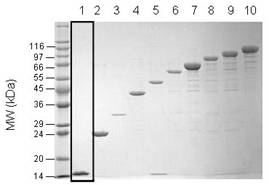Linear polyubiquitin chains are useful tools for investigating, amongst other things, the specificity and reactivity of deubiquitinylating enzymes (DUBs) and the recognition and interaction of linear polyubiquitin modified proteins with ubiquitin binding domain (UBDs) containing proteins.
Product Details
| Alternative Name: | Ub2 |
| |
| MW: | ~17.1kDa |
| |
| Source: | Produced in E. coli. |
| |
| UniProt ID: | P0CG47 (UBB), P0CG48 (UBC) |
| |
| Formulation: | Liquid. In 50mM TRIS, pH 8.0, containing 50mM sodium chloride. |
| |
| Purity: | ≥95% (SDS-PAGE) |
| |
| Purity Detail: | Purified by multistep chromatography. |
| |
| Application Notes: | For use in deubiquitinylating enzyme assays and polyubiquitin binding studies.
Suggested uses:
-
Deubiquitinylating enzyme substrates (general/linkage specific).
-
Investigation of polyubiquitin chain recognition by and interaction with ubiquitin binding proteins.
-
Linear polyubiquitin studies.
|
| |
| Shipping: | Blue Ice |
| |
| Long Term Storage: | -20°C |
| |
| Use/Stability: | Stable for at least 12 months after receipt when stored at -20°C. |
| |
| Handling: | Avoid freeze/thaw cycles. After opening, prepare aliquots and store at -20°C. |
| |
| Scientific Background: | The post-translational modification of proteins with polyubiquitin chains occurs in a wide range of signalling pathways and is tightly regulated in order to ensure cellular homeostasis. The function, processing and ultimate fate of polyubiquitinylated proteins is thought to be determined by the nature of the linkage between adjacent ubiquitin molecules in the polyubiquitin chain.
In addition to lysine-linked polyubiquitin chains the amino terminus of ubiquitin can be used to form head-to-tail polyubiquitin chains, in which the C-terminal Gly of one ubiquitin is conjugated to the N-terminal Met of an adjacent ubiquitin. Such linear polyubiquitin chains are structurally similar to Lys63-linked polyubiquitin, despite the chemical differences between the two linkage types.
Several ubiquitin polygenes are encoded in eukaryotic cells and undergo post-translational processing to generate the cellular source of free ubiquitin monomers. However, linear polyubiquitin chains,in which the C-terminal Gly of one ubiquitin is conjugated to the N-terminal Met of an adjacent ubiquitin, have been shown to be assembled in vitro by an E3 ligase complex, known as the linear ubiquitin chain assembly complex (LUBAC), and ubiquitin binding domains (UBDs) with a preference for linear polyubiquitin have been identified in a number of proteins. A possible role for linear polyubiquitin modification in NF-κB pathway activation, involving linear polyubiquitinylation of NEMO, has also been reported.
Such observations suggest that linear polyubiquitin modification of proteins may play an important role in cellular processes in addition to that of lysine-linked polyubiquitin protein conjugation. |
| |
| Regulatory Status: | RUO - Research Use Only |
| |
Please mouse over
Product Literature References
Silybins are stereospecific regulators of the 20S proteasome: M. Persico, et al.; Bioorg. Med. Chem.
66, 116813 (2022),
Abstract;
General Literature References
Involvement of linear polyubiquitylation of NEMO in NF-kappaB activation.: F. Tokunaga et al.; Nat.Cell Biol.
11, 123 (2009),
Abstract;
Molecular discrimination of structurally equivalent Lys 63-linked and linear polyubiquitin chains.: D. Komander et al.; EMBO Rep.
10, 466 (2009),
Abstract;
Specific recognition of linear ubiquitin chains by NEMO is important for NF-kappaB activation.: S. Rahighi et al.; Cell
136, 1098 (2009),
Abstract;
Mechanism of ubiquitin-chain formation by the human anaphase-promoting complex.: L. Jin et al.; Cell
133, 653 (2008),
Abstract;
Full Text
Proteasome-independent functions of ubiquitin in endocytosis and signaling.: D. Mukhopadhyay & H. Riezman; Science
315, 201 (2007),
Abstract;
A ubiquitin ligase complex assembles linear polyubiquitin chains.: T. Kirisako et al.; EMBO J.
25, 4877 (2006),
Abstract;
Full Text
Intracellular protein degradation: from a vague idea thru the lysosome and the ubiquitin-proteasome system and onto human diseases and drug targeting.: A. Ciechanover et al.; Exp.Biol.Med.
231, 1197 (2006),
Abstract;
Full Text
Distinct monoubiquitin signals in receptor endocytosis.: K. Haglund et al.; Trends Biochem.Sci.
28, 598 (2003),
Abstract;
The ubiquitin-proteasome proteolytic pathway: destruction for the sake of construction.: M. H. Glickman & A. Ciechanover; Physiol Rev.
82, 373 (2002),
Abstract;
Full Text













